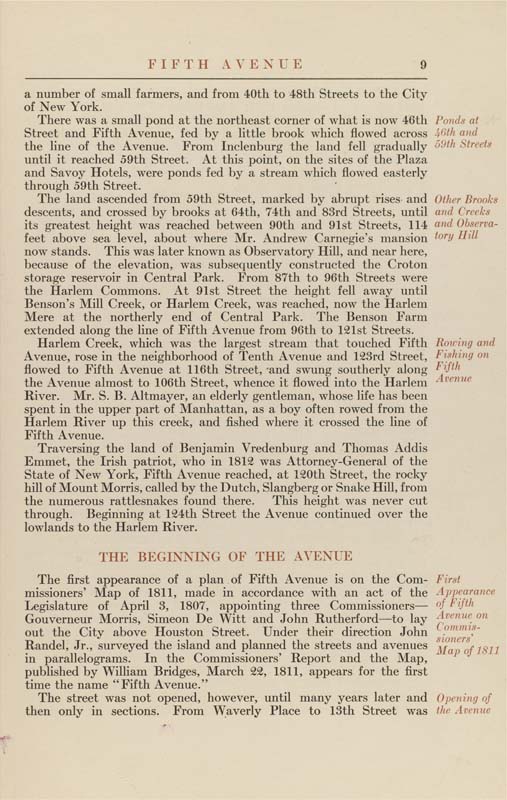a number of small farmers, and from 40th to 48th Streets to the City
of New York.
There was a small pond at the northeast corner of what is now 46th
Street and Fifth Avenue, fed by a little brook which flowed across
the line of the Avenue. From Inclenburg the land fell gradually
until it reached 59th Street. At this point, on the sites of the Plaza
and Savoy Hotels, were ponds fed by a stream which flowed easterly
through 59th Street.
The land ascended from 59th Street, marked by abrupt rises and
descents, and crossed by brooks at 64th, 74th and 83rd Streets, until
its greatest height was reached between 90th and 91st Streets, 114
feet above sea level, about where Mr. Andrew Carnegie's mansion
now stands. This was later known as Observatory Hill, and near here,
because of the elevation, was subsequently constructed the Croton
storage reservoir in Central Park. From 87th to 96th Streets were
the Harlem Commons. At 91st Street the height fell away until
Benson's Mill Creek, or Harlem Creek, was reached, now the Harlem
Mere at the northerly end of Central Park. The Benson Farm
extended along the line of Fifth Avenue from 96th to 121st Streets.
Harlem Creek, which was the largest stream that touched Fifth
Avenue, rose in the neighborhood of Tenth Avenue and 123rd Street,
flowed to Fifth Avenue at 116th Street, and swung southerly along
the Avenue almost to 106th Street, whence it flowed into the Harlem
River. Mr. S. B. Altmayer, an elderly gentleman, whose life has been
spent in the upper part of Manhattan, as a boy often rowed from the
Harlem River up this creek, and fished where it crossed the line of
Fifth Avenue.
Traversing the land of Benjamin Vredenburg and Thomas Addis
Emmet, the Irish patriot, who in 1812 was Attorney-General of the
State of New York, Fifth Avenue reached, at 120th Street, the rocky
hill of Mount Morris, called by the Dutch, Slangberg or Snake Hill, from
the numerous rattlesnakes found there. This height was never cut
through. Beginning at 124th Street the Avenue continued over the
lowlands to the Harlem River.
Ponds at
JiGth and
59th Streets
Other Brooks
and Creeks
and Observa¬
tory Hill
Rowing and
Fishing on
Fifth
Avenue
THE BEGINNING OF THE AVENUE
The first appearance of a plan of Fifth Avenue is on the Com¬
missioners' Map of 1811, made in accordance with an act of the
Legislature of April 3, 1807, appointing three Commissioners—
Gouverneur Morris, Simeon De Witt and John Rutherford—to lay
out the City above Houston Street. Under their direction John
Randel, Jr., surveyed the island and planned the streets and avenues
in parallelograms. In the Commissioners' Report and the Map,
published by William Bridges, March 22, 1811, appears for the first
time the name "Fifth Avenue."
The street was not opened, however, until many years later and
then only in sections. From Waverly Place to 13th Street was
First
Appearance
of Fifth
Avenue on
Commis¬
sioners^
Map of 1811
Opening of
the Avenue
|








